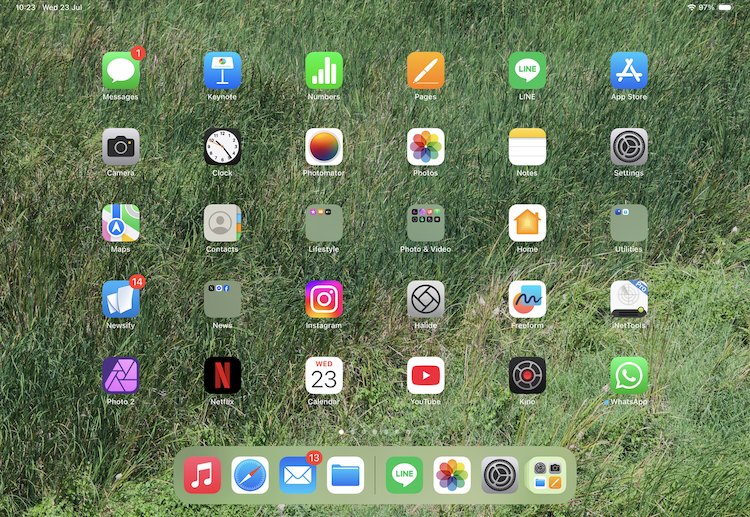
eXtensions - Wednesday 23 January 2025
By Graham K. Rogers

With betas of Apple's OS 26 versions still being worked on, we can expect updates to the current versions soon.The Q3 2025 financial report is next week: rumors abound. Rumors about AI need to be put in their proper context. My experience of AI writing here suggests that students and others need more experience before they can trust their output. I just finished a roll of Phoenix film and a delivery of Phoenix II has arrived.
 Release candidates for iOS 18.6 and other Apple operating systems suggest that these new versions are to be released within a few days, perhaps later this week or early next week (Juli Clover, MacRumors). At the same time, beta releases of the next versions of Apple's operating systems are being updated and released to developers.
Release candidates for iOS 18.6 and other Apple operating systems suggest that these new versions are to be released within a few days, perhaps later this week or early next week (Juli Clover, MacRumors). At the same time, beta releases of the next versions of Apple's operating systems are being updated and released to developers.
That includes beta versions of watchOS. In a note to developers this week, Apple announced that as from April next year, Watch apps must include 64-bit support. It is suggested that developers can use the Xcode build setting of "Standard architectures" which will make a single binary with 64-bit code.
In the meantime, with the Q3 2025 financial report due in a week (31 July) there is much hand-wringing from the usual sources still trying to hit Apple in the run up to the report. Most notable, and for a number of years, are The Information (see comments on AI below), Fortune, and Bloomberg, which makes me wonder about the Mark Gurman rumors. Among the analysts, Morgan Stanley are apparently upbeat about Apple (Malcolm Owen, AppleInsider), despite the "tariff troubles". I see that GM has decided to absorb the $1 billion that tariffs have cost it already this year, so Apple is not alone, although the supply chain does add other problems.
I am not a lover of rumors. Those that are inspired by clever guesswork are sometimes interesting, for example when someone reads the code of one of the operating systems and is able to identify a new device.
However, all too often what we are fed is leaked information. I often wonder if someone high up at Apple is putting information out, although it appears that some may be lower down the food chain (and as Wesley Hilliard reports below, some may be disgruntled employees, or ex-employees).
Marcus Mendes reports that, allegedly, someone with links to Jon Prosser provided information from a development phone that was hacked by Michael Ramacciotti who was staying with the Apple employee, and that the design of what is now iOS 26 was subsequently leaked. The developer has apparently been sacked - password problems at best - while the phone hacker and Prosser are being sued by Apple. As Mendes maps it out, it reads like a detective story. Prosser disputes Apple's version of events. Also covering this is Rajesh Pandey (Cult of Mac). Although the details are more or less the same, this is worth looking at for the different perspective. He also mentions Mark Gurman, and I do wish that Apple would find out who is leaking to him.
One of the areas that has seen some of the most criticism is with Apple's approach to AI. There is a persistent tale that Apple was late to the show, but (as I have reported before) the Machine Learning group was set up several years ago and was producing publications in 2017, a year before John Giannandrea was recruited from Google. However, as Wesley Hilliard (AppleInsider) explains, Apple does not always do what the tech or financial press think Apple should be doing. Apple produces devices and services for its users, not for online pundits; and with AI, there has been considerable caution, while some almost-invisible improvements have been made.
I may not like CleanUp in Photos that much, preferring what I can do in Photomator, but the tool itself does work well in most cases. I am also keenly aware of the limitations of AI, and as Hilliard explains in his article, so is Apple. Where I work, like many in industry and elsewhere, AI has been seen as a sort of savior. This is evident in the enthusiasm for AI in academic writing. What I am seeing, however, is a mess: a word salad; too many words, some of which do not mean what the authors think they do. Four examples I have seen in the last couple of weeks are illustrations of this. The first was a press release that used the term "rounding up with" when "ending up" was correct. Another reported on three presentations that were made at an outside event, "concurrently": at the same time, which would be rather difficult.
Those producing this output do not have the skills or the depth of knowledge about English texts to recognise that the word choice is incorrect, although they become highly defensive if they are reminded of this. It takes me 3 nanoseconds to identify the problem: it's what I do. That second example was concocted using Gemini, the new Google AI. I could see immediately that the staff member had changed the normal approach with the word choice: Pivotal, foster, (foster industrial knowledge creation - tautologous), comprehensive, underscoring, critical, societal, pathway, collaborative, ensued, strategized, attendees.
The same was true of two examples of academic writing I saw recently. So many words, and so many wrongly used, as well as many grammar errors. The first was a graduate thesis. The second was an article that had been returned from a journal, with a number of suggestions, including a recommendation that someone have a look at the English. It was only then that I was asked.
The article by Wesley Hilliard (Apple Insider) is worth reading slowly. He starts with the "combination of unrealistic expectations, fictional narratives, and ignored progress" that takes the place of informed comment, and continues with the "protracted exhale of doom and gloom reporting" before his own analysis, noting that it is "important to remember that "people familiar with the matter" are likely disgruntled employees excited to speak about their pet peeves, and the coverage will likely lean into any negative narratives that help amplify a story."
The problem, he says is not the lack of progress, but Apple's "pursuit of consumer privacy and maintaining product plan secrecy"; adding that these are "opposites of the AI mantra". He notes that "the idea of Apple being behind or caught off guard by AI" is incorrect. Indeed, as I have mentioned, "Apple was at the forefront of machine learning and was even offering Neural Engines in all of its products before it was an industry standard." As I suggest above with my own experience of AI output, Apple is wary of LLMs. They should be. The word used about output, is "hallucination" - I was reminded of Ronald Reagan's comment on disarmament: Trust, but verify. Hilliard is sure that Apple's sure and steady way of working - not releasing a product (usually) until it is doing the job properly - puts it on the right track. In a world filled with exaggerations around AI and its future, we should celebrate the grounded and realistic promises.
I mentioned the student projects I was writing about to a doctor this week. When I mentioned the use of AI, his expression showed disapproval, so I asked him about this. He told me that there was too much reliance on AI in medicine, but did say that the saving factor was that before decisions were made, someone qualified had to sign off on it: trust, but verify.
I had email from a long-time reader of the site this week, thanking me for the notification that the Sleep Apnea feature had finally arrived. As I wrote last time, the reason for the lengthy delay in availability was nothing to do with Apple but local medical authorities. It seems as if the authorities in several countries opened the doors at the same time. In the message, the reader also made a point of thanking me for the work with the engineering students that I am putting online. I have been working on a couple more of these this week to report on the successes students from the Faculty have had in contests here.
I use the Sleep Cycle app in conjunction with the Apple Sleep feature in Health. The app takes data from the Apple Watch while I am sleeping and gives me a percentage score when I wake each day. I am happy if this is in the high 80s or 90s. I rarely hit 100%. Both Sleep Cycle and Apple Health give me graphs of sleep stages, although presented in different ways, which help me understand where I am losing out (apart from bathroom breaks). Juli Clover (MacRumors) reports that it appears Apple is working on "a sleep score feature for the Apple Watch". There does not appear to be an Apple Sleep app on the Watch, but there is a vitals app that shows readings from overnight. That may feed into the Health app on the iPhone.

|

|
With OS26 updates on the way, more information is appearing on what we can expect. Arthur Takur (iDownloadBlog) reports on an interesting feature in the upcoming iPadOS 26 that looks like one of those useful tricks that have been on the Mac since OS X arrived: the Dock. This is available on the iPad currently, but there is not a lot that can be done with it. On the Mac you can resize it, move it to the sides (on the original OS X with some command-line Unix it could be on the top of the screen too). That line in the middle, for example.

On the Mac it is further over to the right and has a number of possible actions when pressed; but not on the iPad, and I wondered what it was for. Arthur Takur explains that "to the left of the Dock's vertical divider . . . your recent apps appear". With iPadOS 26, users will be able to add folders to the Dock, but these will only be allowed on the right, "next to the App Library icon". His article explains that there will be a certain amount of customization allowed. He mentions a couple of other changes, like the traffic light buttons in the top-left corner of windows. From the looks of the screenshots, the updated Dock will also allow more apps or folders to be added to the Dock. This is one of those minor changes that could make a big difference to productivity.

A user in Australia has lost two Instagram accounts after posting photographs of her dogs which Meta decided "breached community standards on "child sexual exploitation" and "nudity"", Pesala Bandara (Petapixel) reports. I am still trying to figure this one out. Of course, once the metacorp has decided the account is to be suspended, then deleted, all appears to be lost as - as many are probably aware - trying to get through to anyone at these companies (and Meta is not alone) is a task fraught with frustration and button presses. Letters from lawyers saw no response. The report includes information about how other users are suing Meta and Facebook in small claims courts, and there is a class action lawsuit being put together in the USA.
A new series on Netflix caught me by surprise and I was totally hooked: Untamed. It wasn't just the talented star, Eric Bana, nor the appearnce of Sam Neill, always a stable presence (even in Peaky Blinders in a way). Nor was it the stunning beauty of the national park. Opening scenes are dramatic and lead into a murder investigation, although the writing suggests initially that this could have been anything from a tragic suicide to a panic escape from an animal attack. But the tenacious investigation of the facts, by a flawed hero (a necessary component of many good TV or movie investigations) throws enough doubt into the mix.
I was initially unsure if his dead son and a missing tourist were connected, but that is the beauty of such a series as I work out possible solutions as the evidence presented to the viewer changes. That particular point was made totally clear in the final episode. This is rumored to be having a second series. Depending on the source used, this is not confirmed, possible, or in the works.
While I am waiting for Netflix to come up with some other interesting programming it has announced that the final season of Stranger Things will be available on 26 November. The second part of the final season of Sandman is slated for 24 July. While waiting for the AppleTV Wednesday and Friday updates, I have started watching Breaking Bad for the third time. It is interesting to look again at the explanation White gives to the chemical topic of Chirality. One molecule with a mirror image that behaves in a different way. This is after all, White and Heisenberg. Jeckyll and Hyde.
While Bryan Cranston was the star of Breaking Bad (with notable support from Anna Gunn, Aaron Paul, Dean Norris, Betsy Brandt, RJ Mitte, Giancarlo Esposito, Bob Odenkirk, Jonathan Banks, Laura Fraser, and Jesse Plemons), the creator was Vince Gilligan who also created the successful spinoff, Better Call Saul, also on Netflix. Now, however, it is reported that AppleTV is to produce a new Gilligan series "starring Rhea Seehorn from Better Call Saul". There is a countdown on the Apple YouTube channel, but details will be announced this Friday, 25 July (Ryan Christoffel, AppleInsider).
In the English West Midlands (think Birmingham) Apple is replacing its smaller, original store, in the Touchwood Mall, Solihull, with a new, larger one right across from it. William Gallagher (AppleInsider) writes about the new Apple store. The image with the article is of the old store and it shows a smallish outlet, which reminded me of the Milton Keynes store I had visited several times in the past.

I wondered if the Milton Keynes store had seen a similar update. It serves a large area, with no other Apple stores nearby. The last time I was there, a few years back now (I bought an Apple Watch that had not yet been released in Thailand), the store was bursting at the seams. Answer, Yes indeed. The image (copied from the Apple UK site) clearly shows a larger store. Well, good.

I had just put the last roll of the original Harman Phoenix into my camera when news of an updated version, Phoenix II was announced. It appeared in the stock list of CameraFilm Photo (in HongKong) so I ordered 5 rolls, along with another 5 rolls of the Kentmere 200. FedEx were supposed to deliver on Wednesday, but the package arrived on Tuesday. A couple of days after placing the order, Jaron Schneider (PetaPixel) wrote a review on Phoenix II: an improvement on Phoenix, but it may not be for everyone. I love trying experimental films in my cameras.

|

|
Graham K. Rogers teaches at the Faculty of Engineering, Mahidol University in Thailand. He wrote in the Bangkok Post, Database supplement on IT subjects. For the last seven years of Database he wrote a column on Apple and Macs. After 3 years writing a column in the Life supplement, he is now no longer associated with the Bangkok Post. He can be followed on X (@extensions_th). The RSS feed for the articles is http://www.extensions.in.th/ext_link.xml - copy and paste into your feed reader.

For further information, e-mail to
Back to
eXtensions
Back to
Home Page